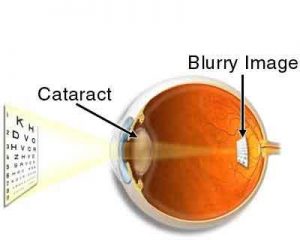- Home
- Editorial
- News
- Practice Guidelines
- Anesthesiology Guidelines
- Cancer Guidelines
- Cardiac Sciences Guidelines
- Critical Care Guidelines
- Dentistry Guidelines
- Dermatology Guidelines
- Diabetes and Endo Guidelines
- Diagnostics Guidelines
- ENT Guidelines
- Featured Practice Guidelines
- Gastroenterology Guidelines
- Geriatrics Guidelines
- Medicine Guidelines
- Nephrology Guidelines
- Neurosciences Guidelines
- Obs and Gynae Guidelines
- Ophthalmology Guidelines
- Orthopaedics Guidelines
- Paediatrics Guidelines
- Psychiatry Guidelines
- Pulmonology Guidelines
- Radiology Guidelines
- Surgery Guidelines
- Urology Guidelines
Dynamin-binding protein linked to congenital cataract

A new study that appeared in the Journal of Human Genetics has now found compelling evidence that links dynamin-binding protein (DNMBP) to congenital bilateral cataract and severe vision loss.
Cataract, being the most common cause of vision loss in older people can be corrected by routine surgery. But congenital cataracts, which occur in infants and children, are particularly serious since they can inhibit visual development leading to permanent vision loss or impairment that cannot be entirely reversed with cataract surgery.
"We were intrigued when 12 individuals from three unrelated consanguineous families of Pakistani descent presented with congenital cataracts and severe to partial loss of vision in both eyes. It was even more puzzling that they showed additional signs of improper visual development. Despite having undergone cataract surgeries, they exhibited no improvement in their visual acuity. This led us to suspect this was a genetic disorder that was affecting more than just the opacity of the eye lens," said Antonarakis, one of the corresponding authors.
Read Also: Diabetics twice more prone to develop cataract
The researchers compared the whole exome sequences of multiple patients from this cohort to the exome sequences obtained from a control cohort of similar ethnicity. This helped them to rule out all the non-pathogenic variants
"We found all 12 patients had mutations in the DNMBP gene on chromosome 10, and even though each of the three families had a distinct type of mutation, it was obvious that the loss of DNMBP was the underlying cause of infantile cataracts and vision loss in these patients," said Dr. Muhammad Ansar, one of the lead authors of the study. "Also, every patient had two defective copies of this gene, indicating that this was likely a recessive disorder, which is common in inbred populations."
The DNMBP protein regulates actin assembly and maintenance of tight junctions between adjacent cells; however, not much was known about its role in eye development. So, to understand how the loss of DNMBP was causing cataracts and vision loss in these patients, the investigators studied the eye of the fruit fly.
The fly eyes undergo similar developmental steps as the human eye - the pupal precursor cells differentiate, the photoreceptors elongate, pigment cells at the apical area of the photoreceptors secrete a lens and bristle cells at the apical end start forming hair-like protrusions that depend on extensive actin polymerization.
"First, we used MiMIC technology to tag the still life (sif) gene, the fly homolog - that is, the fly's functional counterpart - of human DNMBP, with green fluorescent protein (GFP). This showed us that the Sif protein is normally expressed in photoreceptor cells and bristle cells. Then, to understand the role of Sif protein in eye development, we specifically deleted sif gene expression from pupal eyes. The resultant adult flies had subtle rough eyes, a clear indication that the stereotypical arrangement of ommatidia was altered," said Dr. Hyung-lok Chung, the postdoctoral associate in the Bellen lab and the other lead author of the paper.
Read Also: Cataract Rates Continue to Increase, Remains Leading Global Cause of Blindness
Upon further examination of the subcellular architecture of the ommatidia-the optical units-, the rsearchers found that the septate junctions (analogous to vertebrate tight junctions) between different types of neighboring photoreceptor cells in the ommatidia were disorganized. Moreover, pigment cells that secrete the corneal lens were distorted or absent and bristles, a readout of actin cytoskeletal dynamics, were in the wrong position or missing. Most importantly, similar to what had been observed in some of the patients in this cohort, the visual input from the retina was impaired in sif mutant flies. Together, these findings pointed to an evolutionarily conserved role for DNMBP/Sif in regulating actin assembly during eye development.
"This study has uncovered the gene responsible for a recessive Mendelian disorder that causes infantile cataracts and blindness of varying severity. We think our pedigree and molecular analyses will help clinicians and geneticists provide accurate genetic counseling and diagnosis to other similarly affected patients," Bellen said. "Moreover, by generating the first fly model of congenital cataract and vision loss, we have embarked on a journey to understand the precise molecular mechanism behind this genetic disorder, which we are hopeful will lead us to promising therapeutic interventions and better quality of life for these patients."
For reference log on to http://dx.doi.org/10.1016/j.ajhg.2018.09.004

Disclaimer: This site is primarily intended for healthcare professionals. Any content/information on this website does not replace the advice of medical and/or health professionals and should not be construed as medical/diagnostic advice/endorsement or prescription. Use of this site is subject to our terms of use, privacy policy, advertisement policy. © 2020 Minerva Medical Treatment Pvt Ltd